- Navigating Your Midlife Crisis: Embracing New Possibilities
- City Raccoons Showing Signs of Domestication
- Mapping the Exposome: Science Broadens Focus to Environmental Disease Triggers
- One Week Less on Social Media Linked to Better Mental Health
- Your Brain Changes in Stages as You Age, Study Finds
- Some Suicide Victims Show No Typical Warning Signs, Study Finds
- ByHeart Formula Faces Lawsuits After Babies Sickened With Botulism
- Switch to Vegan Diet Could Cut Your Greenhouse Gas Emissions in Half
- Regular Bedtime Does Wonders for Blood Pressure
- Dining Alone Could Mean Worse Nutrition for Seniors
Infertility Is Rising Among Young Married Women

The percentage of married American women under the age of 50 who are infertile rose between 2011 and 2019, new government statistics show.
Data from the National Survey of Family Growth show that “the percentage of married women ages 15-49 who were infertile rose from 2011-2015 (6.7%) to 2015-2019 (8.7%),” according to researchers.
There was a slight rise in infertility (including vasectomies) among men across the same time period — from 11.4% during the 2011-2015 survey to 12.8% in the 2015-2019 survey.
The study was co-authored by Colleen Nugent and Anjani Chandra, of the National Center for Health Statistics. It wasn’t designed to offer up reasons as to why changes in infertility rates might be occurring.
Researchers looked at data based on over 21,000 interviews with women and men ages 15 to 49. Infertility among women was defined as “a lack of pregnancy in the 12 months before the survey, despite having had unprotected vaginal intercourse in each of those months with the same husband or cohabiting partner.”
The analysis also looked at what the researchers called “impaired fecundity” — this was defined as “physical difficulty in either getting pregnant or carrying a pregnancy to live birth.” So, impaired fecundity could be based on the woman and/or her partner being infertile, or it could also be based on difficulties in carrying a baby to term.
Overall, rates on impaired fecundity were stable between 2011 and 2019, Nugent and Chandra reported. Among married women ages 15 to 44, 15.5% had impaired fecundity in the earlier survey, compared to 16% in the later survey.
The report estimates that by 2019 over 8.5 million American women ages 15 to 44 had some form of fertility problem.
Among men who said they were currently infertile, the proportion for whom vasectomy was the reason for their infertility rose sharply with age. For example, the vasectomy rate among this group was 0.3% for men ages 15 to 24, but 40.5% among those ages 45 to 49, the data showed.
The findings were published online April 24 as a National Health Statistics Report.
The researchers stressed that an inability to have a child was not necessarily a medical concern for many of those surveyed.
“An individual or couple can remain infertile or fulfill the definition for impaired fecundity for years after they have stopped trying to have a child or they may not wish to have a child at all,” according to Chandra and Nugent. “There is a wide range of responses to fertility problems that may not involve medical services to have a baby.”
More information
Find out more about the causes and treatments of infertility at the Cleveland Clinic.
SOURCE: National Health Statistics Reports, April 24, 2024
Source: HealthDay
Copyright © 2025 HealthDay. All rights reserved.










